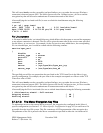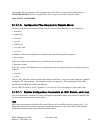named /dev/lmcp0 and /dev/lmcp1 respectively. Control connections must be made prior to
configuration of the /dev/lmcpX devices or undefined errors may result. For Linux systems, the symbolic
library name defined in /etc/ibmatl.conf (e.g., 3494a) should be used.
For RS-232 and Ethernet connected robots, the device special files support both command and async
capabilities. If only one device special file is created, the environment variables or configuration should
be set so that both the command and async ports point to that one special file. It is also possible to create
two device special files and arbitrarily select one to be the command port and the other to be the async
port. The PVR can then be configured to recognize the ports as described above.
HPSS can share an IBM robot with other tape management systems. If a robot is shared, care must be
taken to make sure that a drive is not used by any other tape management system while that drive is
configured as unlocked in the HPSS PVL. This is important because HPSS periodically polls all of its
unlocked drives even if they are not currently mounted. The two LMCP device special files (or possibly
one file in the case of an RS-232 or Ethernet controlled robot) are not available to other tape management
programs. Additional device special files may be created for other programs. Other programs can send
commands to the robot at the same time as HPSS through the additional device special file.
If the robot is placed in pause mode by an operator, an alarm will appear on the HPSS operator window.
All subsequent robot operations will silently be suspended until the robot is put back in automatic mode.
5.1.1.2. AML PVR Specific Configuration
5.1.1.2.1. AML PVR Specific Configuration Window
Field Descriptions
Cartridge Capacity. The total number of cartridge slots in the library dedicated to this HPSS PVR.
This may or may not be the total cartridge capacity of the library; a site might use part of the library for
some other HPSS PVR or for some non-HPSS application. The PVR uses the Cartridge Capacity field
and the Cartridge Alarm Threshold field to determine when to send an alarm that the total cartridge
threshold has been exceeded.
Cartridge Alarm Threshold. The percentage of the Cartridge Capacity at which the PVR will send an
alarm.
Same Job on Controller, Other Job on Controller, & Distance To Drive. These values are used by the
PVR when selecting a drive for a tape mount operation. The three values are essentially weights that are
used to compute an overall score for each possible drive. After the score has been calculated, the drive
with the lowest score is selected for the mount. If two or more drives tie for the lowest score, one drive is
selected at random. The score is calculated as follows:
Score =
Weight 1 * Cartridges from this job mounted on this drive’s controller +
HPSS Management Guide November 2009
Release 7.3 (Revision 1.0) 113


















